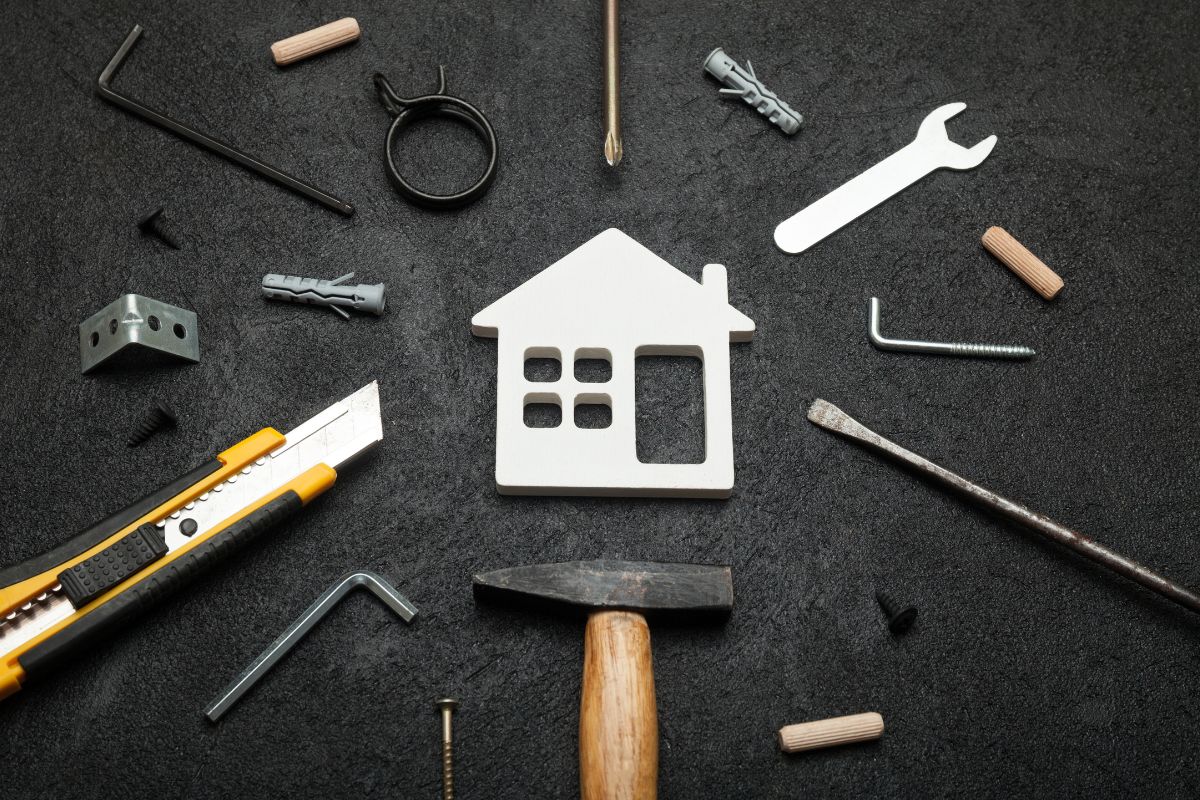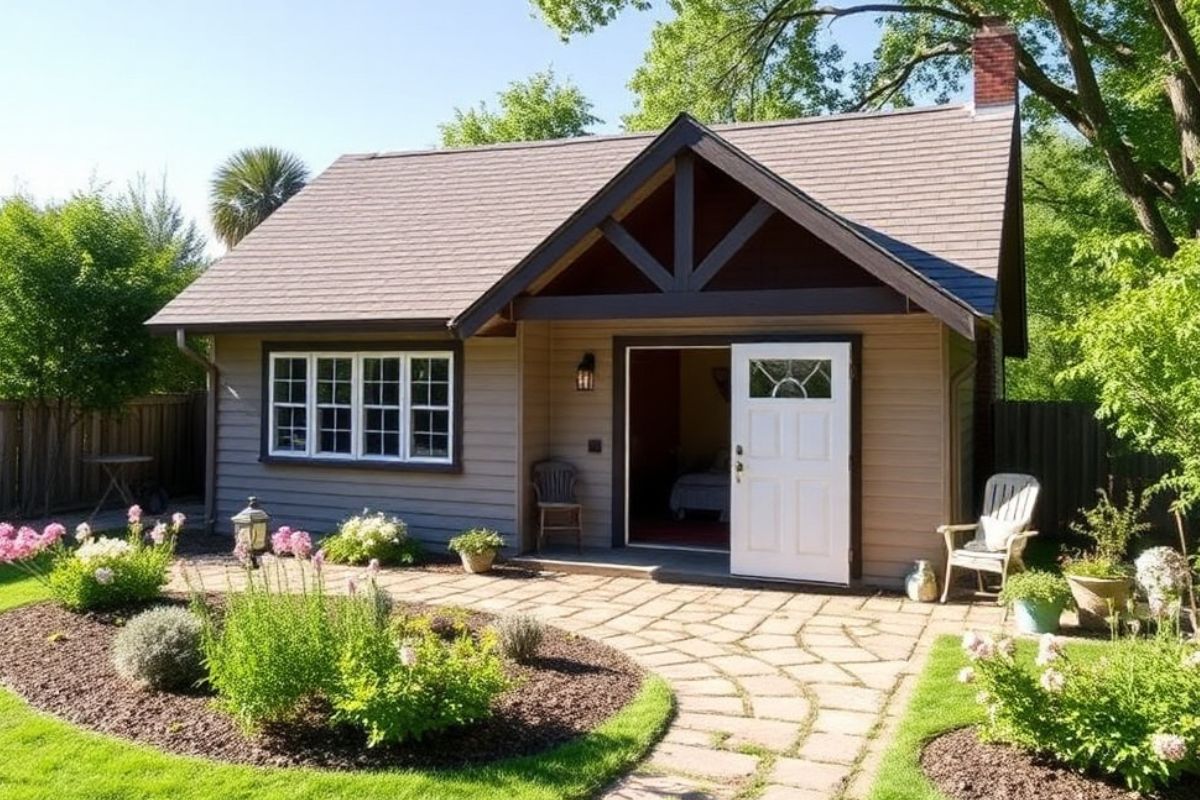When building a tiny house yourself, start by defining your goals and establishing a realistic budget. Research local zoning laws, plan your design by prioritizing space usage, and aim for efficient layouts with multifunctional areas. Choose sustainable materials and maximize vertical space with lofts and shelves.
Understand plumbing and electrical basics to guarantee safety. Consider eco-friendly solutions and professional consultations for complicated elements. Discover more about managing permits and legal requirements for smooth integration.
Key Takeaways
-
Prioritize multifunctional spaces to maximize utility and adaptability in your tiny house.
-
Use renewable and locally sourced materials for sustainability and reduced environmental impact.
-
Plan your layout to ensure plumbing and electrical systems are safely and efficiently integrated.
-
Maximize vertical space with lofts and ceiling-high storage to optimize limited square footage.
-
Stay informed on local zoning laws and building codes to ensure legal compliance with your build.

Planning Your Tiny House Build
Before you begin your tiny house journey, it’s essential to plan thoroughly to guarantee success. Start by defining your goals—consider why you want a tiny house and how it fits into your lifestyle. Next, establish a realistic budget, accounting for materials, permits, and unexpected expenses. Research local zoning laws and building codes to verify compliance, as these can vary greatly by location.
Decide whether you’ll build it yourself or hire professionals. If you’re DIY-ing, assess your skills and identify areas where you might need help. Create a detailed timeline with milestones to track your progress. This structured approach helps you stay organized and reduces stress, ensuring you’re prepared for each step of the build.
Selecting the Right Design and Layout
With a solid plan in place, it's time to focus on the design and layout of your tiny house. Start by identifying your priorities. Do you need a workspace, or is a larger kitchen more important? Consider multifunctional spaces that can adapt to different uses. Sketch out a basic floor plan, keeping traffic flow in mind. Make certain there's enough room to move comfortably and avoid cramped areas.
Maximize vertical space by incorporating lofts for sleeping or storage. Use furniture that doubles as storage to keep clutter at bay. Keep windows strategically placed to enhance natural light and ventilation. Remember, every square foot should serve a purpose. By thoughtfully planning your design and layout, you’ll create a functional and comfortable tiny home.
Choosing Sustainable and Durable Materials
When building your tiny house, selecting sustainable and durable materials is essential for both environmental impact and longevity. Start with renewable resources like bamboo or reclaimed wood for floors and walls. These options reduce waste and add character. For insulation, consider sheep's wool or recycled denim, which provide excellent thermal properties and are eco-friendly.
Metal roofing is a robust choice that reflects heat and lasts decades with minimal maintenance. Opt for low-VOC paints and finishes to improve indoor air quality. Additionally, look for Energy Star-rated appliances to guarantee efficiency. Don’t forget to source locally whenever possible to lower transportation emissions. By prioritizing these materials, you’re not only building a sturdy home but also supporting a healthier planet.

Mastering Efficient Space Utilization
Maximizing every square inch is vital in a tiny house, where space is a premium. Start by designing multi-functional furniture. A sofa that doubles as storage or a foldable table can save room and add utility. Use vertical space effectively; install shelves and cabinets up to the ceiling. Consider lofted sleeping areas to free up the floor for living and working spaces.
Opt for sliding doors instead of traditional swinging ones to save space. Use light colors to create an illusion of openness and strategically place mirrors to reflect light, making the space feel larger. Prioritize decluttering regularly to guarantee every item has a purpose. Remember, thoughtful planning and innovative solutions turn small spaces into cozy, efficient homes.
Understanding Plumbing and Electrical Basics
Grasping the essentials of plumbing and electrical work is crucial for any tiny home builder. You'll need to understand basic water systems, including how to connect pipes and install fixtures like sinks and showers.
Choose compact solutions, such as tankless water heaters, to save space. For the electrical system, familiarize yourself with wire gauges, circuit panels, and outlet placement. Safety is paramount: make sure you install ground fault circuit interrupters (GFCIs) in areas prone to moisture, like the kitchen and bathroom.
Plan your layout carefully, making sure that water and power lines don't cross paths. Consider using flexible PEX piping for plumbing due to its durability and ease of installation. For electrical, consult a professional to review your setup before finalizing, making certain compliance and safety.
Navigating Permits and Legal Requirements
Steering through the world of permits and legal requirements can be intimidating, but understanding them is essential to avoid future headaches. First, research local zoning laws, as these dictate where you can legally place your tiny house. Some areas have minimum square footage requirements, so verify your plans comply. Contact your local building department to confirm if you need a construction permit. Requirements vary, and some places might categorize tiny houses differently, impacting the necessary permits.
Investigate utility connections, including water, sewer, and electricity. These often require inspections and specific permits. If your tiny house is on wheels, check if it’s classified as a recreational vehicle (RV), which may change legal considerations. Always keep documentation organized and stay updated with any regulation changes to verify compliance.

Incorporating Energy-Efficient Solutions
When building your tiny house, integrating energy-efficient solutions can considerably reduce your environmental footprint and utility bills. Start by choosing high-quality insulation, which keeps your home warm in winter and cool in summer. Opt for energy-efficient windows to minimize heat loss.
Installing solar panels is a smart way to harness renewable energy, reducing reliance on the grid. LED lighting throughout your home uses less electricity and lasts longer than traditional bulbs.
Consider energy-efficient appliances, as they consume less power without sacrificing performance. Incorporate a rainwater collection system for watering plants or non-potable uses. A tankless water heater can provide hot water on demand, saving energy. By implementing these strategies, you'll create a sustainable and cost-effective tiny home that meets your needs.
Conclusion
As you commence on your tiny house journey, remember that careful planning and design will set you up for success. Choose sustainable materials and make the most of every inch. Get familiar with plumbing and electrical basics to avoid surprises. Don’t overlook permits and legalities—these are essential for a smooth build.
Finally, embrace energy-efficient solutions to guarantee your home is both eco-friendly and cost-effective. With these expert tips, you’re well-equipped to create your dream tiny home.






Share: